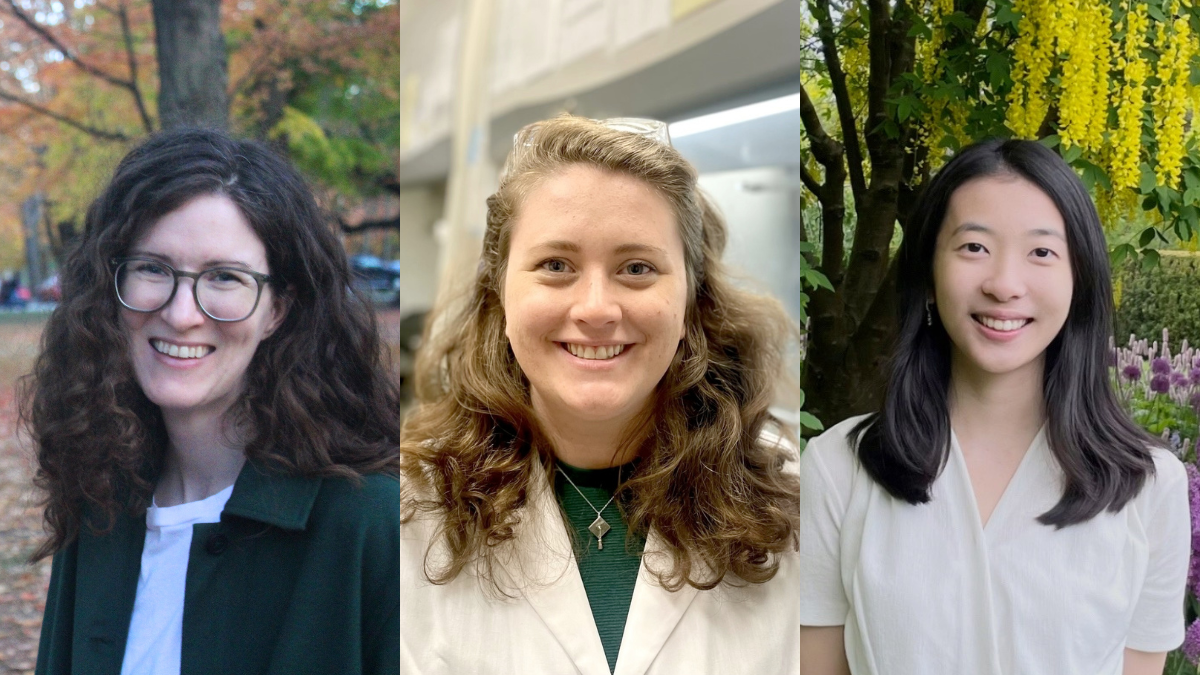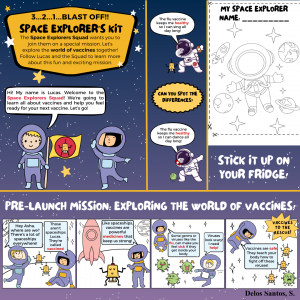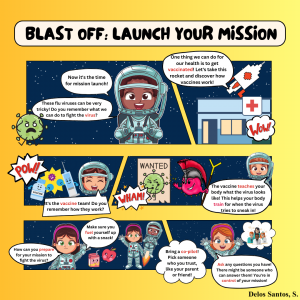Contest Winners Find New, Fun Ways to Explain Vaccine Science
April 26/2024
Winning entries, and honourable mentions, from the inaugural Explain It Like I’m 6: A Vaccine Education Contest.
By Betty Zou and Ishani Nath
Aliens, wizards, ninjas and an inquisitive bunny named Muffin. These are just a few of the characters the Centre for Vaccine Preventable Diseases (CVPD) and Emerging & Pandemic Infections Consortium (EPIC) were introduced to during the inaugural Explain It Like I’m 6: A Vaccine Education Contest.
The contest was open to students at any Canadian university, and invited applicants to submit a short essay, video or graphic(s) explaining an aspect of vaccine science in a way that a 6-year-old would understand. Some used fairytales to explain the battle between viruses and vaccines. Others created clever animations to illustrate complex concepts in simple terms. There were even a few original songs (which CVPD and EPIC staffers can still be heard singing in the hallways). In the end, EPIC and the CVPD received more than 30 applications from students across Canada.
“The entries we received put a smile on my face when I reviewed them,” says CVPD Director Shelly Bolotin. “Our contestants found creative and clear ways to explain how vaccines work and how they protect individuals as well as communities — messages that are particularly timely given the low rates of routine childhood immunizations and the threat of preventable diseases like measles.”
The contest was held in the lead up to National Immunization Awareness Week (April 22 to 30) to promote the need to make vaccine science accessible and to counter misinformation.
“The COVID-19 pandemic highlighted the critical role that clear and effective communications play in safeguarding public health,” says Scott Gray-Owen, Academic Director of EPIC and a professor of molecular genetics at the University of Toronto’s Temerty Faculty of Medicine. “We hope that initiatives like this one will provide opportunities for the next generation of science communicators to hone their skills and for the public to be engaged by the fun format while they learn something new.”
A shortlist of submissions was put to the ultimate test: reactions from seven grade one classrooms to determine the Kids’ Choice Award winner. It was a fun and engaging exercise for the students that led to lively discussions and learning new concepts related to vaccines.
Without further ado, here are the winners from the inaugural Explain It Like I’m 6: A Vaccine Education Contest:

(From L to R: Stacey J Butler, Aideen Teeling and Abigail Netanya Ngan)
First Place: Stacey J Butler for “Vaccines vs Viruses: The Ultimate Battle”
Stacey Butler didn’t have to look far for inspiration for her winning submission on how vaccines train our immune system to counter viruses. “I have a 6-year-old nephew,” says Butler, a PhD student in U of T’s Institute of Medical Science. “His name is Austin, and he loves superheroes and video games.” Austin’s interests became the foundation for her animated video, which uses the common analogy of the immune system as an army to defend the body against viruses.
Butler says she was influenced by dual coding theory in deciding what type of submission to enter into the contest. The theory suggests that the human brain processes verbal and nonverbal information — for example, words and images — through two different channels and that information stored in two channels can be more easily remembered. “Using both images and words helps you recall information, so I thought if I could have some visuals, that would help children latch onto these analogies,” she says.
This is not Butler’s first foray into science communications, an area for which she has a clear passion. She has presented her research on lung cancer and chronic obstructive pulmonary disease to patients and helped create a patient education fact sheet about long COVID.
Even though her research is not related to vaccines, she felt motivated to enter the contest by what she observed during the COVID-19 pandemic. “Seeing how misinformation spiraled with the pandemic into people having mistrust in vaccines and becoming less keen on using other vaccines for things like measles, I saw this contest as a way to fight that misinformation using science communications,” says Butler.
As she prepares to defend her PhD in the coming months, Butler sees science communications remaining an important part of her career journey moving forward. She hopes to pursue a postdoctoral fellowship in implementation science with Samir Gupta, a clinician-scientist at Unity Health Toronto and an expert in knowledge translation.
And as for Austin? “He was quite proud to have had some small contribution to the video.”
Runner Up: Aideen Teeling for “Why Boosters Matter”
“I was kind of in a rut,” says Aideen Teeling, a graduate student in U of T’s Department of Laboratory Medicine and Pathobiology, when asked about why she chose to apply to the Explain It Like I’m 6 contest. Searching for a way to reinvigorate her passion for science, she took a step back and thought about what she wanted to contribute to the field. Teeling realized she’s passionate about viruses, vaccines and digestible science communication. The Explain It Like I’m 6 contest was the perfect opportunity to combine those interests and see what she could make.
Teeling submitted a short, animated video explaining the concept and importance of vaccine boosters. The animation outlines how viruses make us sick, how vaccines protect against viruses, and the role boosters play in ongoing protection.
Completing her contest entry gave her a new level of appreciation for the art of translating vaccine science. “I have a degree in immunology, I’m doing my master’s in vaccine research and some of these topics are really hard to understand,” she says. “There’s so much information out there and it’s so political and polarizing right now, I can totally see how the average person gets lost.”
To make vaccine science accessible to anyone over the age of 6, Teeling advises simplifying the science down to only the necessary details. For instance, she notes that there are hundreds of reasons why someone would need a booster, but in her video, she only focused on two: virus mutations and immune system aging. (It’s worth noting that Teeling’s entry was also a favourite among the first-grade students judging our Kid’s Choice Award.)
Teeling is an international student and hopes that her success in the Explain It Like I’m 6 contest inspires other students to put themselves out there. “Sometimes when you’re international, you kind of want to blend in or just focus on your work,” she says. “I really encourage people to try something like this, because it helps your communication skills, especially if you’re English [as a] second language. It’s really worthwhile.”
Kids’ Choice Award: Abigail Netanya Ngan for “Vaccines are for Protection”
For Abigail Netanya Ngan, the Explain It Like I’m 6 contest was a perfect opportunity to combine her love of music with her passion for microbiology and immunology. The fourth-year University of British Columbia undergraduate student is studying microbiology, immunology and public health, topics that have captured her attention since high school.
Her video entry was inspired by shows from her own childhood like Little Einsteins and Wonder Pets!, which use music and puppets to deliver fun, engaging and educational content to young children. “The first thing that came to my head was that children might possibly view vaccines as something very scary,” says Ngan. “I wanted to show that vaccines are not scary, vaccines are there to protect them.”
Her video was chosen as the winner of the Kids’ Choice Award after voting by seven classes of grade one students.
A musician with experience in singing, songwriting, piano, guitar and ukulele, Ngan estimates that it took her four to five weeks to write the lyrics and musical score for her original song, record the tune on the ukulele, create the storyline, film the music video and edit the song and video together.
Looking ahead, Ngan won’t rule out the possibility of Muffin the bunny coming back as part of a video series to teach young students about other important concepts in biology and immunology. “One of my dreams as a science communicator is to be able to inspire a new generation of children to find passion in the sciences.”
HONOURABLE MENTIONS
Joy Ly for “Communicable Diseases”
Our judges loved how University of Calgary nursing student Joy Ly used costumes, different sets and storytelling to explain the concept of communicable diseases in an entertaining and informative TikTok video.
“I wanted to figure out a way to address a younger crowd in a way that was engaging and fun for them to learn from,” says Ly. “With TikTok being an increasingly popular platform, I thought that creating a video in that style would resonate more with elementary school students who are growing up with that kind of content.”
Seanthel Delos Santos for “Space Explorer’s Kit”
The judges were very impressed by the submission from Seanthel Delos Santos, a McMaster University student studying in the Physician Assistant Education Program. Delos Santos created a two-sided placemat with activities and comic strips touching on different aspects of vaccine science (click the images below for the full size downloadable images).
“I wanted to create an accessible comic form that empowers children to take charge of their own vaccination journey,” says Delos Santos. “This approach facilitates positive experiences during youth to carry with them into adulthood.”
Special Thanks
We would like to thank the English grade one classes at Earl Beatty Public School, Grafton Public School and Swansea Public School for their enthusiastic participation in the Kids’ Choice Award judging.

